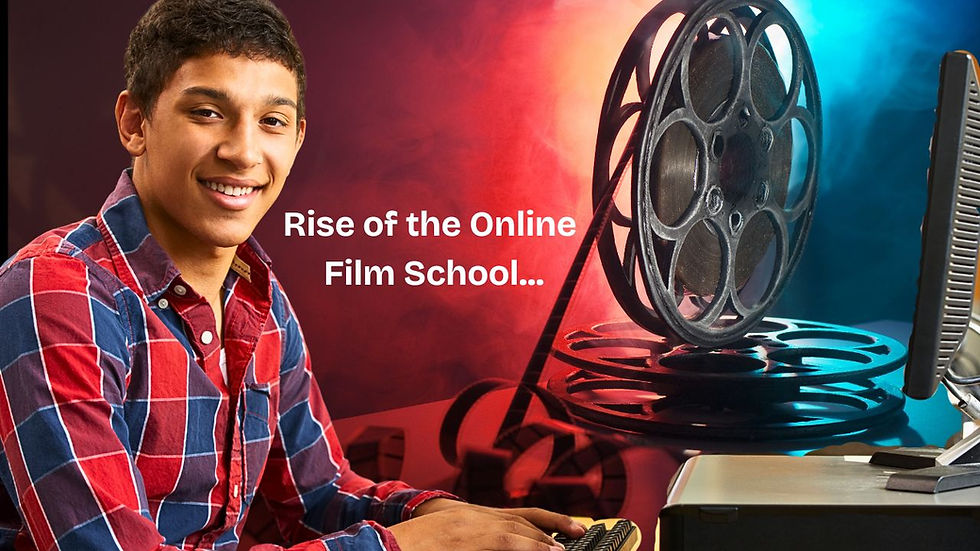- Eddy Sanchez

- Jul 26
- 3 min read
The Rise of Online Film Schools: Are They Worth It?

In recent years, online film schools have been experiencing a remarkable surge in popularity. This trend is largely attributed to the flexibility and accessibility they offer aspiring filmmakers. However, as the number of these institutions continues to grow, it raises an important question: Are online film schools truly legitimate, or are they simply selling dreams?
Increased Accessibility and Flexibility
One of the most significant advantages of online film schools is the increased accessibility they provide. For many students, the traditional classroom setting can be challenging to navigate due to work commitments or personal responsibilities. Online programs allow students to create their own schedules, making it easier to balance their education with daily life. This flexibility has opened the doors for a broader range of individuals to pursue their passion for film, regardless of their circumstances.
Focus on Specialized Skills
As the film industry continues to evolve, so do the skills required to succeed within it. Online film schools are increasingly offering specialized programs that cater to specific areas such as digital filmmaking, content creation, and even emerging technologies like virtual reality (VR) and augmented reality (AR). This focus on specialized skills is essential in a competitive industry where staying ahead of the curve can make all the difference.
Integration of Industry Professionals
Another notable trend in online film education is the integration of industry professionals as instructors. Many programs feature educators who are active in the film and television industry, providing students with valuable insights and networking opportunities. This connection to the industry can be a game changer, as students learn not only the technical aspects of filmmaking but also the nuances of navigating a competitive landscape.
Technological Advancements
The incorporation of immersive technologies like VR and AR into online film curricula is also noteworthy. These advancements are transforming the learning experience, enabling students to engage in interactive and practical projects that mirror real-world scenarios. As technology continues to shape the film industry, online schools are adapting to meet these changing demands.
Adaptation to Online Distribution
In an age where online distribution is becoming the norm, film schools are evolving their curricula to reflect this reality. Topics such as digital media marketing and online platforms are now integral components of many programs, equipping students with the knowledge they need to succeed in a rapidly changing landscape.
The Financial Burden of Film School
While there are many advantages to attending film school, it's crucial to acknowledge the significant financial investment required. For instance, the annual cost for undergraduate film and television programs at USC's School of Cinematic Arts (SCA) is approximately $68,237 for tuition and fees. When factoring in additional expenses like books, supplies, room and board, and other living costs, the total estimated cost of attendance can soar to around $90,453 per year.
Here's a detailed breakdown of the costs:
- Tuition and Fees: $68,237
- Books and Supplies: $1,200
- Room and Board: $19,198
- Other Expenses: $1,818
- Total Estimated Cost of Attendance: $90,453
It's important to note that these figures represent the costs for the 2023-24 academic year and may vary in the future. Additionally, different programs within the School of Cinematic Arts may have slightly different tuition rates; for example, the MFA in Film & Television Production has a first-year tuition of $49,495 for 18 units.
Despite the substantial financial commitment, many graduates find themselves entering a highly competitive job market without guaranteed employment. Not every student emerges from film school debt-free, and the reality is that landing a job in the film industry can be uncertain. Many individuals pursue film schools primarily for the connections they can make within the industry. However, with online programs, the question arises: Who will you meet if everything is virtual? This is a critical aspect to consider when weighing the value of an online film education.
Conclusion
As the landscape of film education continues to change, online film schools are emerging as a viable option for many aspiring filmmakers. However, it's crucial to approach this trend with a discerning eye. By asking the right questions and doing thorough research, students can make informed decisions that align with their career aspirations.
In summary, online film schools are very intriguing. But the question remains; are they worth it? I think it depends on who you are and how much effort you are willing to put into your education and networking with the high price tags associated with them.
#FilmEducation, #OnlineFilmSchools, #Filmmaking, #DigitalFilmmaking, #FilmIndustryConnections, #VirtualReality, #AugmentedReality, #ContentCreation, #EWritesPodcast, #FilmSchool



